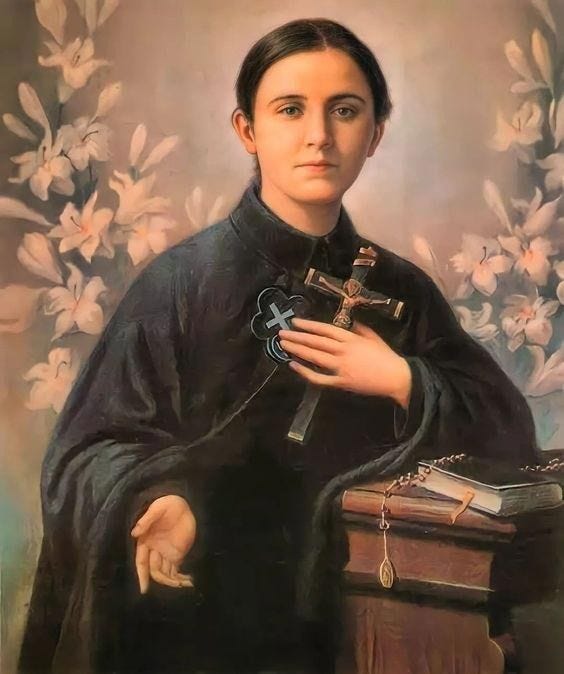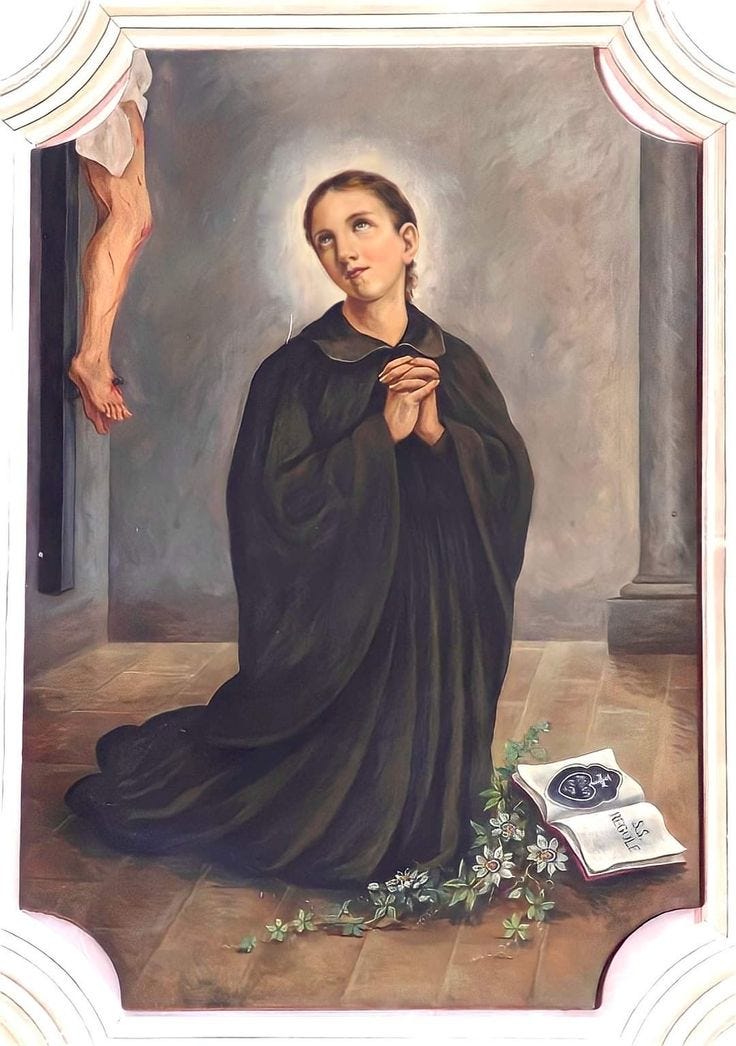St. Gemma Galgani: Her Virtues and Daily Routine
Gemma's chief thought, and the ardent incessant desire of her heart, was to become like Jesus.
Introduction
Gemma Umberta Maria Galgani was born on March 12, 1878, in Italy. She was the fifth of eight children of Enrico Galgani, a prosperous pharmacist, and his wife, Aurelia. Gemma’s life was marked by suffering, losing her mother, father, and several siblings to illnesses, yet amidst her suffering she was elevated to the heights of perfection and was granted the great favor of supernatural healings and mystical experiences, the most notable of which was the Stigmata. Gemma had a deep devotion to the Passion of Christ, and her greatest desire was to "become like Jesus." As Jesus was the Man of Sorrows, she asked to become a "child of sorrows." She is sometimes referred to as "the daughter of the Passion" due to her imitation of the sufferings of Christ. Her spirituality closely aligned with that of the Passionists, and she had a special devotion to and spiritual friendship with St. Gabriel of Our Lady of Sorrows, a Passionist.
The Backstory
1886
Gemma's devout and cherished mother, Aurelia Galgani, succumbed to tuberculosis. This was a devastating blow to the 8-year-old Gemma.
1897:
Gemma's father went bankrupt, leaving his family in severe financial hardship. Shortly after, he developed throat cancer and died. Gemma was 18 years old.
All his property was gone, and his seven children and two sisters had no means of living or any hope except in Divine Providence. In these great sufferings, some of the children's aunts came to their assistance in part.
Gemma was invited to stay with her wealthy aunt. Although Gemma’s only pleasure was to remain in the house, working, praying, and being alone with Jesus, she was not free to devote herself entirely to her devotions while in her aunt’s home. Her suffering was acute; she was unable to receive the Eucharist as frequently as she desired, and Jesus left her in a state of desolation with no consolation during this time.
Gemma ultimately persuaded her aunt to allow her to return to her siblings in Lucca. She found her home as she had left it: in poverty and desolation.
1889-1899:
In Lucca, she endured a severe and dangerous illness but had a miraculous recovery. Despite the joy of her recovery, the Galgani household remained in distress, with the children often going to bed hungry with nothing to eat.
Spring, 1899:
Restored to health, Gemma sought the solitude of religious life; however, she was ultimately not accepted into a convent.
June, 1899:
Gemma received the Stigmata and subsequently experienced this phenomenon beginning every Thursday evening and lasting until Friday afternoon.
In 1899, Gemma was welcomed into the devout Giannini family. The family comprised a father, mother, twelve children, and the father's sister, Cecilia. It was the deeply pious Cecilia who took an interest in Gemma and sought permission to bring her into the household. Gemma was received with great warmth by the entire family, with the parents embracing her as if she were their own child. Cecilia, who was highly advanced in spiritual matters, understood Gemma's inner life and became a great support to her.
Gemma’s Daily Routine in the Giannini Household
She slept little, and in the morning she arose very early without delay, as soon as she heard Cecilia get up.
She spent five minutes or less washing and dressing for the day. In a spirit of poverty and detachment, she had only two dresses and a hat.
She desired to dedicate the first moments of her day to Jesus. She attended daily Mass with Cecilia, attending two Masses and receiving the Eucharist daily.
Back at home, she would immediately set to work, assisting the young girls with dressing and saying their morning prayers.
She would always have something to do in her hand, mending, darning, or knitting, as she moved about the house, wherever her presence was needed. She did not like handiwork that was showy and vain, such as ornate embroidery, but preferred practical tasks that were useful for the family.
She participated in any menial housework that needed to be done; nothing was beneath her. She would draw water from the well, assist the maids in cleaning the house, wash dishes in the kitchen, or help the cook prepare meals.
Cecilia frequently desired Gemma's company, prompting Gemma to bring her handiwork and spend time with Cecilia. They would engage in conversations about spiritual matters. Gemma found herself able to confide in Cecilia in a manner she could not with others.
If Cecilia was unavailable, Gemma would continue her handiwork in her room in solitude or in the home chapel, praying while she worked.
During meals, she consumed very little. She would join the family, take a few bites, and then excuse herself, retreating to her room while the others continued to chat at the table.
When strangers arrived at the house, she withdrew: firstly, out of politeness, and secondly, to avoid being distracted by conversations that did not interest her.
If anyone in the household was sick, she tended to them with great care.
She derived immense satisfaction from assisting any destitute beggar who approached the door. It was her delight to invite the impoverished inside, provide them with nourishment, and converse with them about spiritual matters, urging them to attend Mass and receive the Sacraments.
Gemma felt immense gratitude towards her benefactors and prayed fervently for them, asking God to reward their kindness by shielding them from misfortune. She even went so far as to pray that their troubles would bypass them and befall her instead, so that she might endure suffering in their place:
“My God, how shall I be able to correspond to all that they do for me? I don’t even know how to thank them, I am so uncultivated and ignorant. See to it Thou, O my God. Make them prosper and repay them a hundredfold for all they do for me. If any misfortune is about to befall them, let it fall on me instead.”
Gemma’s Holy Simplicity
Gemma was the essence of holy simplicity. Simple in her ways, simple in her bearing, simple in her dress, simple in her belongings. She lived in strict simplicity and had only the bare necessities.
She was entirely resigned to the will of God; in all that concerned her, she calmly waited to see what He would decide.
She was simple in thought, thinking no evil, and thus never fell into rash judgment against others. She seemed incapable of conceiving thoughts of vainglory.
Gemma’s simplicity of mind and heart was so great that she also had great simplicity in her speech. In conversation she was reserved and spoke little.
By what means did Gemma attain to perfection?
Detachment.
Perfect Obedience.
Profound Humility.
Heroic Mortification
Heroic Patience
Gemma used to say that it was to her mother she owed her knowledge of God and her love of virtues. Gemma’s mother, Aurelia Galgani, was “a saint” and perfect model. She prayed continually, received the Eucharist daily with vivid faith, and prioritized Mass by allowing no obstacle to prevent her from going to church. From the Eucharist, she drew strength to perfectly fulfill her duties.
It was her mother who first taught her to compassionate Jesus in His sufferings, showing to Gemma images of the crucified Christ and teaching her the mystery of the Love of God and how a Christian ought to respond to it. She taught Gemma how to pray and habitually prayed with her — in the morning, in the evening, and very often during the day. It was Aurelia who instilled in Gemma a fervent longing for heaven.









What happened to all of St. Gemma's siblings that had been in poverty when St. Gemma entered into the new house with the Giannini family?
Additionally, what were St. Gemma's fallings? How did she struggle? From this account, she seems to be almost not human.
I thought the summary otherwise charming and engaging. Pax tecum.
St. Gemma, pray for us.